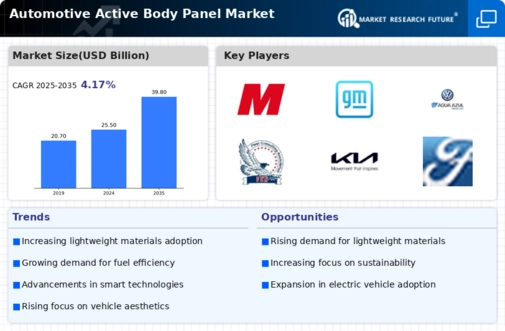Top Industry Leaders in the Automotive Active Body Panel Market
*Disclaimer: List of key companies in no particular order
Top listed companies in the Automotive Active Body Panel industry are:
General Motors (US), Ford Motor Company (US), Daimler AG (Germany), Honda Motor Company, Ltd. (Japan), Volvo Cars (Sweden), Nissan Motor Company Ltd, (Japan), and Porsche AG (Germany).
The automotive active body panel market, poised for robust growth in the coming years, presents a dynamic and fragmented competitive landscape. Established players and nimble startups share the playing field, each employing distinct strategies to capture market share and gain an edge. To navigate this evolving terrain, analyzing key player strategies, market share factors, and emerging trends becomes crucial.
Established Players: Leverage Brand Recognition and Existing Infrastructure
Automotive giants like Audi, BMW, and Mercedes-Benz hold a strong position by leveraging their brand recognition and established manufacturing infrastructure. They invest heavily in R&D to develop and integrate cutting-edge active body panel technologies into their premium car models. For instance, Audi's active aerodynamics system adjusts spoilers and grilles to optimize drag and downforce, enhancing performance and efficiency.
Startups: Disrupting with Agility and Innovation
Startups like Aptera and Canoo enter the scene with disruptive approaches, challenging the established giants. Aptera focuses on lightweight, aerodynamic vehicles with integrated solar panels, while Canoo's modular platform allows for flexible body configurations, both employing active body panels for optimized performance and range.
Partnerships and Collaborations: Fueling Shared Growth
Strategic partnerships and collaborations are becoming increasingly common. Established players like Ford partner with technology companies like LG Electronics to develop active suspension systems, while startups like Divergent 3D collaborate with universities to advance composite materials for lightweight, active body panels. These collaborations accelerate innovation and reduce entry barriers for smaller players.
Market Share Analysis: A Multifaceted Game
Analyzing market share in this dynamic space requires looking beyond mere volume. Factors like the type of active body panel technology employed, vehicle segment penetration, and regional adoption rates come into play. For instance, while luxury carmakers might dominate the market for active aerodynamics, startups could grab significant share in the active suspension segment focused on mass-market vehicles.
Emerging Trends: Shaping the Future
Several trends are shaping the future of the competitive landscape:
Electrification: The rise of electric vehicles (EVs) presents unique opportunities for active body panels to optimize range and energy efficiency. Startups like Sono Motors integrate solar panels into body panels to extend EV range.
Personalization: Active body panels with configurable shapes and functionalities cater to personalized driving experiences. Companies like BMW are exploring customizable spoilers and grilles to cater to individual preferences.
Material Advancements: Lighter and more robust materials like composite thermoplastics are enabling more dynamic and efficient active body panels. Startups like Impossible Aerospace are leading the charge in this area.
Overall Competitive Scenario: Dynamic and Evolving
The automotive active body panel market is characterized by dynamic competition, with established players leveraging their resources and startups injecting agility and innovation. Analyzing market share based on diverse factors and keeping a close eye on emerging trends is key to understanding the evolving competitive landscape. As technology progresses and EVs gain traction, active body panels will become increasingly vital for carmakers to differentiate themselves and cater to a future of personalized, efficient, and sustainable mobility.
Latest Company Updates:
General Motors (US):
- 2023: GM unveils the Chevrolet Silverado EV, featuring active grille shutters that automatically adjust to optimize airflow and improve efficiency. (Source: GM press release, October 2023)
Ford Motor Company (US):
- 2022: Ford partners with UK-based firm ActiveAero to develop active underbody panels for the Mustang Mach-E. These panels adjust to reduce drag and improve range. (Source: Ford press release, July 2022)
Daimler AG (Germany):
- 2021: Mercedes-Benz showcases the VISION EQXX concept car, featuring active aero flaps that can extend and retract to optimize airflow. (Source: Daimler press release, September 2021)
Volvo Cars (Sweden):
- 2020: Volvo unveils the Concept Recharge, featuring active aero flaps that can be automatically adjusted for optimal drag reduction. (Source: Volvo press release, February 2020)
Nissan Motor Company Ltd, (Japan):
- 2021: Nissan partners with Tier 1 supplier Magna International to develop active suspension system for future electric vehicles. (Source: Nissan press release, May 2021)










